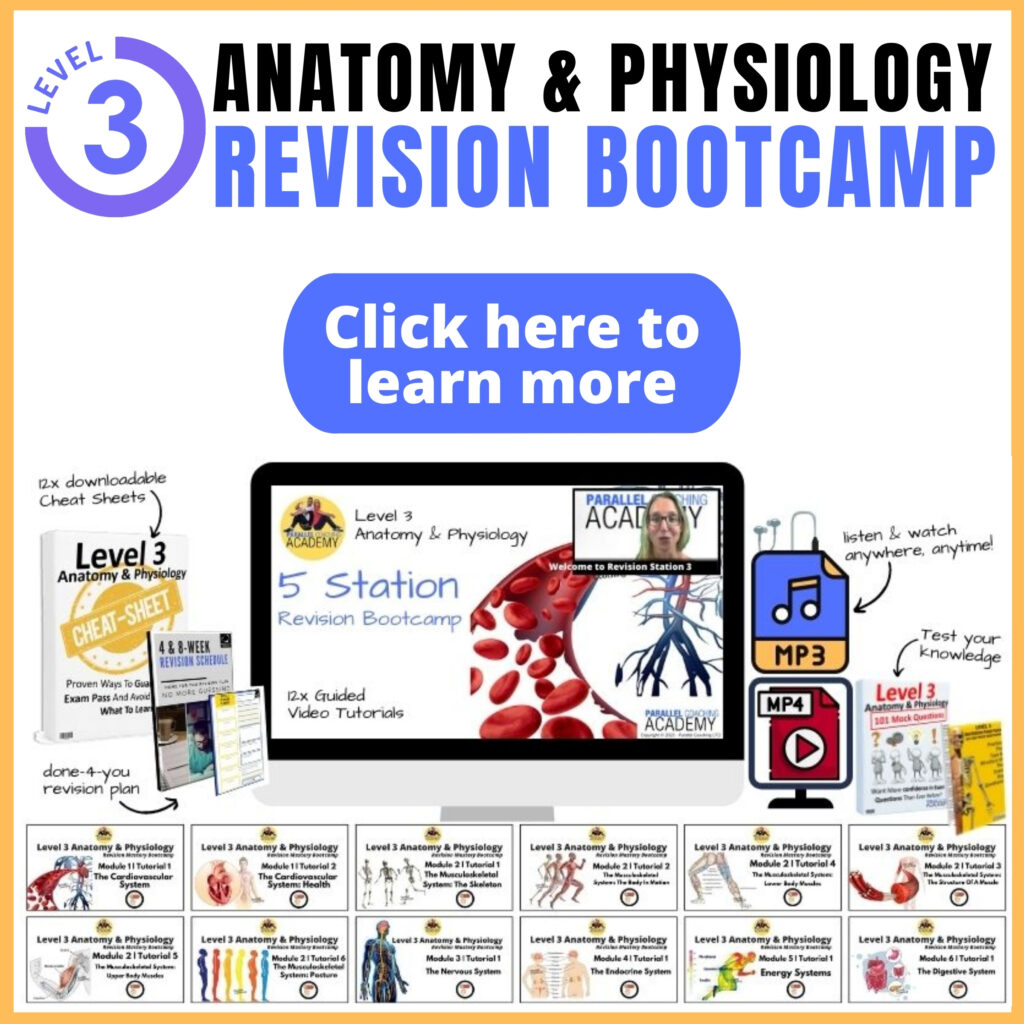This week’s edition of “mock question dissection” explores the energy system used in interval training
What I like about this mock question… it links your anatomy and physiology knowledge to training a real client.
Remember, you are training a client towards a specific goal. The client only achieves their goal through logical progressed training.
It’s the stimulus of this training that forces an anatomical and physiological adaption.
With that said… let’s take a look at today’s mock question to dissect.
Which energy system will be predominantly used during the work phase of a Tabata?
A. Adenosine Triphosphate
B. Lactic Acid System
C. Creatine-Phosphate System (ATP-CP)
D. Aerobic System
As we dissect this mock question I want to break the rest of this blog into 3 sections.
- An Exam tip to unpick the toughest of questions.
- A brief insight into the 3 energy systems and why you need to know them beyond the exam.
- An overview of a Tabata and interval training.
Also, I’ve placed 3 more fitness exam mock questions below relating to energy systems. These will help you become more confident in your knowledge and ready to tackle your final exam.
When tackling any mock questions it’s crucial you follow the K.I.N.G.S Formula.
^^^
That’s my exam tip. Follow this quick 5 step process allowing you to unpick every exam question.
I wrote another blog and completed a webinar about using the K.I.N.G.S Formula… the links are at the bottom in the PS section.
The K.I.N.G.S Formula
- Gets you to slow down.
- To read the question for what it is.
- To have a clear strategy to unpick the toughest of questions.
The first step of the K.I.N.G.S Formula is K.
K for ‘Keywords’.
Finding the keywords from an exam question gives you clarity of the topics you’re being tested on.
Let’s find the Keywords in today’s mock question:
Keywords include:
‘Energy Systems’, ‘work phase’, and ‘Tabata’.
Next in the K.I.N.G.S Formula is I.
What do “I” know about the keywords?
This leads nicely into section 2 of today’s mock question dissection.
Here I’ll briefly overview energy systems and why you need to know them beyond your exam.
Exploring “Energy” as a Keyword .
First up. We get our energy from the food we eat.
Well, not directly. The energy in our food does a bit of fancy footwork before it reaches our blood cells and goes to work.
At its source, energy is made up of 3 things:
1) Carbohydrates
2) Proteins
3) Fats
Each of these is broken down during digestion. To become glucose, amino acids, and fatty acids, respectively.
Glucose, amino acids, and fatty acids are then absorbed into the blood cells. Simply put, where they become adenosine triphosphate (ATP) aka. our body’s currency for fuel.
Just like a car uses petrol as fuel… the human body’s fuel is ATP.
The process from raw carbohydrates,
to the final stage of synthesizing ATP requires many complex physiological pathways.
I’ll cover this in a future blog and stay on track with today’s mock question dissection.
Next… let’s explore the 3 main energy systems?
Well, one of them you may be familiar with – the aerobic system.
The other two are:
The ATP- Creatine- Phosphate (CP) system and the Lactic acid system.
Let’s look at all three in more detail, starting with
the Aerobic Energy system…
The aerobic energy system is also known as the oxygen energy system. It uses both carbohydrates and fat in a slow energy burn and oxygen must be present in order for this to take place.
The aerobic energy system uses oxygen to create something called glycolysis. A fancy name and process to produce that all-important ATP.
The aerobic energy system generates energy in our mitochondria.
Consider the mitochondria as the body’s power plant.
It’s all a very complicated and somewhat a slow process. It’s also heavily reliant on the flow of oxygen from our circulatory system.
As a result, the aerobic energy system is the slowest to act of the three.
It’s widely documented…
any physical activity lasting more than 3-minutes predominately uses the aerobic energy system.
Next is the ATP- Creatine Phosphate energy system (ATP-CP-System).
Think of all those short, sharp bursts of energy such as a 100-meter sprint or fast bouts of intervals.
These are both examples that utilise the ATP-CP System. A short, intense bout of movement that lasts no more than 10-seconds.
All this happens in an anaerobic state. Meaning, without the presence of oxygen. Instead, ATP-CP is stored in the body’s muscles and replenished via phosphocreatine breakdown.
Finally… energy system number 3: The Lactic acid energy system.
So the aerobic energy system deals with our longer endurance energy needs
and the ATP-CP system covers all the super short bursts.
The lactic acid energy system deals with everything in-between.
From 10-sends to 3 minutes of intense physical activity.
The lactic acid system is also anaerobic, meaning without the presence of oxygen. The lactic acid system uses stored glucose (muscle glycogen) to produce energy (ATP).
In summary: There are 3 Energy Systems
- Anaerobic Alactic (ATP-CP) Energy System (High Intensity – Short Duration/Bursts)
- Anaerobic Lactic (Glycolytic) Energy System (High to Medium Intensity – Uptempo)
- Aerobic Energy System (Low Intensity – Long Duration – Endurance).
Let’s remind ourselves of today’s mock question. We can then explore the final two keywords.
Mock Question =
Which energy system will be predominantly used during the work phase of a Tabata?
The final two keywords include: “Work phase” and “Tabata” and these are somewhat linked.
A Tabata is a type of interval.
Interval training consists of alternating time periods of work and rest.
Let’s explore the Tabata.
A full Tabata lasts only four minutes.
It has a clear structure of… Work out hard for 20 seconds and rest for 10 seconds.
This makes up 1x interval and you complete 8 intervals back to back, lasting 4-minutes.
Choosing 1 or multiple exercises you push yourself as hard as you can for 20 seconds and rest for 10 seconds.
The 20 seconds of hard work is the “work Phase”. Immediately followed by 10-seconds of rest/recovery.
The aim is to push and work as hard as you can for 20 seconds. Aiming for RPE 7+ out of 10.
Side Note:
Based on the intensity a Tabata is an advanced training system. A client should logically progress towards completing a Tabata over several weeks.
… I’m sure we could agree a Tabata is not easy, performed at high intensity, with a short burst of hard work.
This fits the description of the ATP-CP energy System above for the work phase of the Tabata.
In the case of this mock question, the answer would be…
C = Creatine-Phosphate System (ATP-CP)
Using the K.I.N.G.S. formula gets quicker the more you practice it.
So your next logical step is… learn all 8 modules in the anatomy and physiology section of your course
(you could use the Revision Mastery Bootcamps for this)
https://revision.parallelcoaching.co.uk/fitness-exam-revision-courses
and then test yourself using mock questions… at the same time practice using the K.I.N.G.S. formula so come exam day you are confident in both your knowledge and the exam.
I recently recorded a short K.I.N.G.S. formula webinar with Neale. It’s 24-minutes long and you can access it for FREE here >>>https://parallelcoaching.co.uk/how-to-unpick-tough-fitness-exam-mock-questions
What’s important to take away here:
Learning anatomy and physiology is NOT only about passing your exam. Yes, you need to pass your anatomy exams to qualify as a FITPRO.
I want you to consider that every time you plan and train a client… you are, in fact, training the client’s energy systems.
In order to plan and deliver effective sessions.
To select the appropriate FITT (Frequency, Intensity, Time and Type)
To select the right intensity, training variables, and exercises…
You must know how the body’s energy systems are fueled and how they work.
Remember, at the top of today’s blog, I said.
“Remember, you are training a client towards a specific goal. The client only achieves their goal through logical progressed training.
It’s the stimulus of this training that forces an anatomical and physiological adaption”.
Test your knowledge with today’s Energy System mock questions:
[NOTE: The answers are below the 3rd questions]
Q1: Which energy system is predominantly used in a Marathon?
A. Adenosine Triphosphate
B. Lactic Acid System
C. Aerobic System
D. Creatine-Phosphate System (ATP-CP)
Q2: How can you tell your client is training in an anaerobic energy system?
A. Unable to talk, breathing is faster and signs of fatigue
B. Can keep a conversation going easily
C. Breathing rate is reduced and the client feels fresh
D. Able to talk, breathing rate is reduced
Q3: Which Energy System has fatiguing Bi-Products?
A. Adenosine Triphosphate
B. Lactic Acid System
C. Aerobic System
D. Creatine-Phosphate System (ATP-CP)
Answers to the mock questions are :
Question 1= C, Question 2 = A, Question 3 = B
If you want more mock questions like this, then you can download more Free Mock Questions: DOWNLOAD NOW
Need More Help with your Level 3 Anatomy Revision?
For Trainee FITPROS Taking Their L3 Anatomy & Physiology Exam.
Learn, Revise & Pass Your Level 3 Anatomy & Physiology Exam In Under 10-hours
(Without Having To Spend Hours Revising Or Feeling Overwhelmed)
If you want to get your revision structured, learn everything you need to know and feel confident on exam day, then click the link below:

Dedicated to More
Hayley “Energy System” Bergman
Parallel Coaching
P.S. You can also find us on the following platforms:
Instagram: Follow Now
Facebook: Like Our Page
Twitter: Tweet Us
YouTube: Subscribe Here
More Anatomy Revision Blogs: HERE

